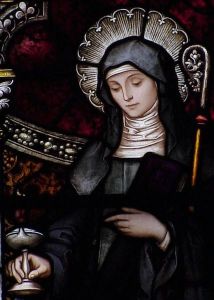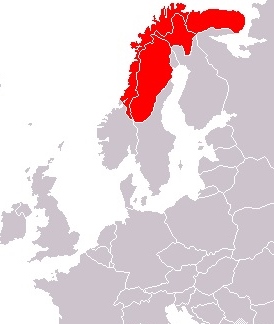All in all this article is pretty good. I support all efforts to resurrect Olde Yule, and get to the roots of many of our holiday traditions. There are just a couple of items mentioned here, though, that I would like to address.
Influences that preceded Santa:
 One great point in the article is something I have been saying right along, that Santa is an amalgam of many influences – BUT he is not simply Odin repackaged like a lot of Asatru bloggers keep saying. There seems little doubt that the white bearded Odin/Woden/Wotin who flew through the air on his magical horse to participate in the Wild Hunt at Yuletide was certainly a major influence. However, there are many other influences to consider. The archetype of the wise man, magician, sorcerer was prevalent in Northern European society from Britain to Russia. Certainly Odin is a part of this tradition, as he is known as the Wanderer in pointed wide-brimmed hat, tattered robes, often carrying a staff or walking stick. He is associated with magic, bringing us the Runes and he is said to have learned the Norse magical tradition called “Seidr” from Freyja.
One great point in the article is something I have been saying right along, that Santa is an amalgam of many influences – BUT he is not simply Odin repackaged like a lot of Asatru bloggers keep saying. There seems little doubt that the white bearded Odin/Woden/Wotin who flew through the air on his magical horse to participate in the Wild Hunt at Yuletide was certainly a major influence. However, there are many other influences to consider. The archetype of the wise man, magician, sorcerer was prevalent in Northern European society from Britain to Russia. Certainly Odin is a part of this tradition, as he is known as the Wanderer in pointed wide-brimmed hat, tattered robes, often carrying a staff or walking stick. He is associated with magic, bringing us the Runes and he is said to have learned the Norse magical tradition called “Seidr” from Freyja.
 However, the image of the mage, the wise sage who is a wielder of magic is seen elsewhere in Europe. Think Merlin, Taliesin, and Finnish sorcerers/wizards which are so common in old Finnish folklore.
However, the image of the mage, the wise sage who is a wielder of magic is seen elsewhere in Europe. Think Merlin, Taliesin, and Finnish sorcerers/wizards which are so common in old Finnish folklore.
Shamanic influences are also strongly theorized to be an influence on Santa. The Finnish wizards were affiliated with Finno-Ugric shamanic tradition. Another FInno-Ugric group with a strong shamanic tradition are the Saami. Their shamans were known to eat the red and white fly agaric costume and then journey to the spirit world aided by the beating of their drums. These drums were often adorned with jingle bells.
Other figures across Europe follow this same pattern of being influenced by “the wandering sorcerer” archetype. Ded Moroz is one such Christmas figure from Russia (pictured above). And the English Father Christmas is another (pictured below). I do understand that other internet writers aren’t as well versed in European folklore, so they don’t mean to be dismissive of other cultures. But, I personally feel it is disrespectful to other Northern European cultures whose traditions have a legitimate influence on Santa Claus to leave them out.
Saints were usually made up by monks to dissolve cults to local deities:
Another point of contention I have with the “influences” of Santa mentioned in the article, and this is no fault of the author as it is the common theory espoused about the “history” of Santa, is Saint Nicholas.
Now, a bit of nerdy Medieval explanation is necessary. When one is a student of Medieval Studies, one becomes familiar with a genre of writing not well known by the general public: hagiography. Hagiography is a genre of literature dealing specifically with saints’ lives. However, it differs from biography because hagiographies were written with an agenda to spread the Catholic cult of saints. They were very popular during periods of conversion, when the church targeted locally venerated deities and attempted to replace them with Christian saints. One such swap out is very well known – goddess Brigid to Saint Brigid.
 In their campaign to build up the saint while diminishing the god, hagiographers literally made shit up. Straight up inventions based on nothing but the imagination of the writer. They bullshitted their way through it. Sometimes a real figure could be used as a model, and then merged with the god they were trying to erase. But the lives were typically completely contrived, and all manner of miracles and benevolent acts were ascribed to the newly invented saint.
In their campaign to build up the saint while diminishing the god, hagiographers literally made shit up. Straight up inventions based on nothing but the imagination of the writer. They bullshitted their way through it. Sometimes a real figure could be used as a model, and then merged with the god they were trying to erase. But the lives were typically completely contrived, and all manner of miracles and benevolent acts were ascribed to the newly invented saint.
Therefore, it is my strong opinion that the Saint Nicolas theory is but more bunk that was put round by the Church to distract people from their traditional Christmas figures. Many local Yuletide characters were unsavory to the church. Italy’s Befana is a witch, and Germany’s Krampus is a creepy goat-man with likely roots as a Pan-like agrarian deity, just to give two examples! There may well have been one or more real life men who the story of Saint Nick was based on. But, more than likely, the story was purposefully devised to replace and distract people from Odin and the other figures mentioned above.
** Edit – Someone made a comment on Facebook that “the author is downplaying the real Saint Nicholas.” Ahem. In helping a friend find scholarly sources for Valentines Day, I was reminded that it was yet another holiday rooted in a pagan past; the old Roman Lupercalia. Saint Valentine was grafted on to the holiday in the SAME way as St. Brigid became the patron saint of Candlemas, which was formerly Goddess Brigid’s Imbolc. If you don’t see a pattern here and want to continue to believe the tale of “real” Saint Nicholas, you go right ahead.**
Santa’s reindeer are not based on a horse. They are based on, erm, reindeer:
 Another point of contention is the assertion that Santa’s reindeer are based on Odin’s magical horse Sleipnir. As explained above, the bearded magic man flying through the air at Yule does have connections to Odin and his flying horse. However, the reindeer are more than likely inspired by the Saami reindeer herders.
Another point of contention is the assertion that Santa’s reindeer are based on Odin’s magical horse Sleipnir. As explained above, the bearded magic man flying through the air at Yule does have connections to Odin and his flying horse. However, the reindeer are more than likely inspired by the Saami reindeer herders.
Although the Saami are largely unknown by the general American public today, they were referenced quite often in writings of the 19th century when the American version of Christmas as we know it today was formed. Back then they were referred to as Lapps, and they were of great interest to folklorists and travel writers to whom “Lapland” was an exotic and fascinating foreign location.
Reindeer herding has been a traditional livelihood of the Saami for hundreds, if not thousands, of years. The Saami live at the tippy top of Scandinavia reaching from Norway and Sweden to Finland and over to Russia. Most of this area is considered Arctic, and it is virtually undeniable that the Saami in Lapland (Sapmi is the politically correct term for this region today) were a huge influence on our image of “The North Pole.”
The Saami tie to Santa’s reindeer goes beyond simply the coincidence of them being affiliated with reindeer in the North Pole. As mentioned above, Saami shaman used the fly agaric mushroom to spirit travel. Well, as we would have it, the Saami reindeer herders did as well. According to folklore and historical sources, the Saami herders would watch when their reindeer rooted out the mushrooms from beneath the snow. After the reindeer ate the shrooms, the herders would collect their urine and drink it to “fly” themselves. And there you have it: flying reindeer. This is pretty straightforward and difficult to debate. Sorry, Sleipnir! Not that I don’t love you and your eight legs or anything, but I’m not going to make up a tenuous connection just to pander to what people want to read! Especially when the truth is equally cool! If you don’t believe me, maybe BBC can explain it to you:
Fly agaric was a super uber common motif in German, Norse, and Finnish Christmas, which in all likelihood is a hold over from old Yule All you have to do is Google it and you will find numerous images like the one below which clearly demonstrate how Santa got his red and white suit (Sorry, Odin! No rags for Santa!):
** Quick edit with massive EYE ROLL and condescending sigh. Yes, Coca-Cola made today’s image of Santa famous. Duh. We all know that. But this article is more about addressing the information given by the other article referenced at the top than an exhaustive meticulous history of American Christmas. However to address some comments made on Facebook… ahem, do you think the artists working for Coke lived in a vacuum? Obviously they lived in the same culture as everyone else and were exposed to the same culturally pervasive motifs and imagery that were common to the time. As I said above, the fly agaric mushroom was a popular Christmas symbol and that pre-dated modern images of Santa. Coke’s artists, just like everyone else at the time would have seen these everywhere. So when they were choosing colors for his outfit, there could be little question as to whether these images played a large role in their inspiration.**
Christmas Caroling began in Pagan Europe, not in the Christian 15th Century:
One last thing to mention. The article mentions Christmas “songs” going back to the 4th century in a Christian context, and that carols originated in the 15th century. Again, no blame on the author as this information is very hidden and not well known. But Christmas caroling is a VERY pagan tradition! It is yet another indigenous European pre-Christian custom that the Church literally rallied and launched campaigns against. They finally decided to try to wipe out the pagan custom by replacing it with a Christian one, the same tactic mentioned above with the saints. Please read this article which explains it in detail: The Hidden History of Christmas Carols.
 And there we have it. ~ Aelfie
And there we have it. ~ Aelfie
Please check out our section for Pagan roots of modern holidays in our shop. I will be developing and adding more great resources and recommendations to it 🙂


